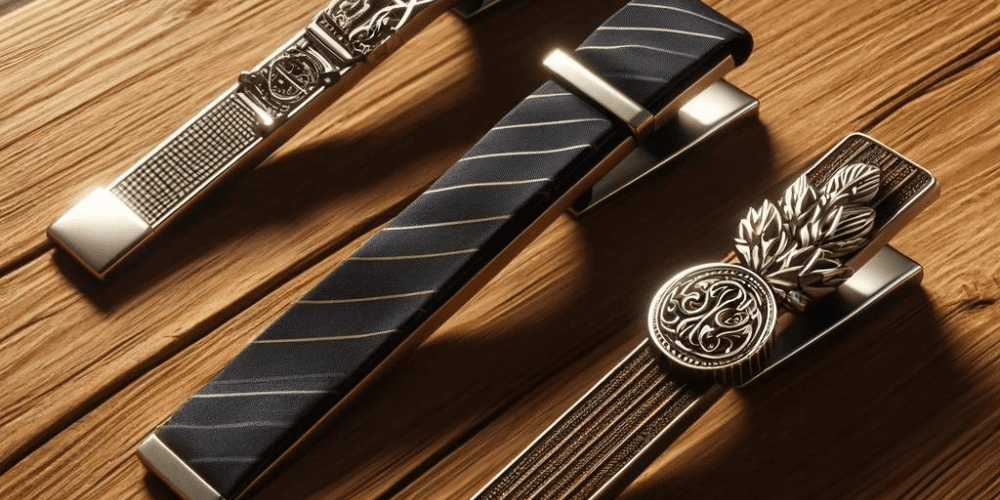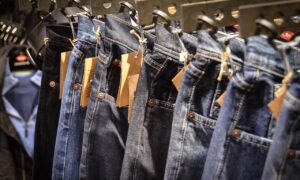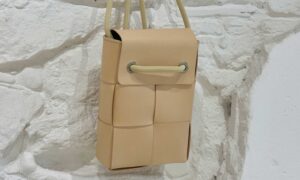Introduction to Tie Bar
Definition and Initial Purpose
The tie bar, a slim piece of metal worn across the tie to clip it to the shirtfront, has origins deeply rooted in practicality. Initially, it was designed to keep a man’s tie neatly in place, preventing it from swinging about and ensuring a sharp, professional appearance at all times. This accessory, also known as a tie clip, tie slide, or tie clasp, served a distinct purpose: to secure the tie to the shirt placket, averting any potential for the tie to dip into the soup or get caught in office machinery.
Overview of Evolution from Function to Fashion
Over the years, the tie bar has evolved significantly, transforming from a strictly utilitarian item into a statement of style and personality. Its journey mirrors the fashion industry’s shift towards accessories that not only serve a function but also contribute to the overall aesthetics of an outfit. From silver and gold to brightly colored and patterned designs, the tie bar has become a subtle yet powerful tool for self-expression within the modern gentleman’s wardrobe.
Historical Origins and Early Use
The Emergence of the Tie Bar
The history of the tie bar dates back to the early 19th century. With the rise of industrialization, the need to keep one’s tie out of the way while working with machinery became a matter of safety as well as appearance. Early iterations of the tie bar were simple, functional, and typically made from affordable materials that could withstand daily use without drawing too much attention to itself.
Functionality in the Military
Within the military, the tie bar found an essential role. As uniform standards required a neat and disciplined appearance, the tie bar was utilized to ensure that soldiers’ ties remained in place even in the midst of physical exertion or adverse conditions. This practicality solidified the tie bar’s presence in men’s wardrobes as a necessary item for anyone concerned with maintaining proper decorum and uniformity.
Transition to a Fashion Accessory
Incorporation in Civilian Attire
As soldiers returned from service and reintegrated into civilian life, they brought with them the sartorial habits fostered in the military, including the use of a tie bar. The accessory was adopted by the public and began to be recognized not only for its practical benefits but also as an element of sophisticated dress. It was no longer uncommon to see a tie bar on the shirt of a businessman or a star of the silver screen.
Changing Perceptions in the 19th and 20th Centuries
Throughout the 19th and 20th centuries, as fashion trends ebbed and flowed, so too did the popularity of the tie bar. The roaring twenties saw it as an emblem of put-together style, while the post-war era embraced it amid the rise of consumer culture and mass-produced fashion. By the mid-20th century, it was not just an accessory but a signifier of one’s attention to detail and familiarity with the rules of dress.
The Tie Bar in Modern Times
Decline and Resurgence
Despite its deep-rooted history, the tie bar did face a period of decline. The cultural revolutions and relaxed dress codes of the late 20th century saw traditional men’s accessories fall out of favor. However, the turn of the millennium brought a revived interest in classic menswear and with it, the resurgence of the tie bar. It re-emerged as not only a nod to the past but also a modern fashion statement with the ability to adapt to contemporary trends.
Variations and Modern Implementations
In the modern fashion landscape, the tie bar boasts numerous styles and designs. From minimalist clips that blend seamlessly into a professional ensemble to statement pieces that pop with color and creativity, there’s a tie bar for every occasion. Designers have innovated with the classic silhouette, incorporating novel textures, materials, and mechanisms, making the tie bar a versatile component in the dapper gentleman’s accessory repertoire.
Types of Tie Bars
Classic Clasp
The classic clasp is the archetype of tie bars, featuring a straightforward design that clasps the tie and shirt together. It maintains a low profile while providing the functional benefit of keeping the tie neatly in place. Classic clasps come in various lengths and materials, making them a timeless choice for those who value elegance and simplicity.
Slide Bar
The slide bar offers a slightly different approach, with a piece that slides over the tie and shirt without the clasping mechanism. This style often results in a smoother look as there is no hinge or clasp to add bulk. The slide bar’s sleek design appeals to the minimalist and is perfect for those seeking an unobtrusive yet stylish accessory.
Chain Link
A throwback to the more decorative styles of the past, the chain link tie bar exudes an old-world charm rarely seen in modern accessories. This type of tie bar uses a short chain to tether the tie to the shirt, providing a vintage aesthetic that stands out for its elegance and uniqueness. Chain link tie bars are for the fashion-forward individual who appreciates the melding of form and function with a touch of historical reference.
Tie Bar Materials and Craftsmanship
Common Materials Used
Tie bars come in various materials, including common metals such as stainless steel, brass, and copper. These metals are often chosen for their durability, ease of manufacture, and affordability. The accessibility of these materials means that anyone can incorporate a tie bar into their wardrobe without breaking the bank while maintaining a polished look.
Luxury and Designer Materials
For those with a penchant for luxury, tie bars can also be crafted from precious metals like sterling silver, gold, and even platinum. The craftsmanship involved in creating these high-end accessories is often more detailed, with designers incorporating intricate patterns, engravings, or even precious gems to appeal to discerning customers. Designer tie bars can act as a subtle mark of status and offer an additional layer of sophistication to an ensemble.
How to Wear a Tie Bar
Placement and Proportions
The placement of a tie bar is crucial for achieving the desired effect. Typically, it should be positioned between the third and fourth buttons of a shirt to maintain balance. Proportion-wise, a tie bar should never be wider than the tie itself; it should span approximately three-quarters the width of the tie to preserve symmetry and present a well-proportioned appearance.
Coordination with Ties and Outfits
When coordinating a tie bar with an outfit, it’s important to consider the color, pattern, and texture of the tie. The metal of the tie bar should complement other accessories like cufflinks or a watch. For a cohesive look, one might select a tie bar that resonates with the overall theme of the attire, be it a formal, conservative setting or a more casual, eclectic scene.
Tie Bar Etiquette and Styling
Formal vs. Informal Occasions
The tie bar finds its place in both formal and informal settings. For formal events, a classic, subdued tie bar is preferred, in line with the solemnity of the occasion. Conversely, informal or creative gatherings allow for more expressive choices in tie bar style, color, and design. Regardless of the occasion, the rule of thumb is that a tie bar should always add to the outfit without dominating it.
Latest Trends and Celebrity Influence
Fashion trends often draw inspiration from popular culture and celebrity style. As public figures are frequently seen sporting tie bars, they have become an accessible and desirable accessory for many. From red carpet events to talk show appearances, celebrities have showcased an array of tie bars, influencing public perception and trends. This celebrity influence ensures that the tie bar remains a relevant and dynamic aspect of men’s fashion.
Customization and Personalization
Engraving and Custom Designs
Personalized tie bars offer a level of individuality that standard models cannot match. Engraving a tie bar with initials, a special date, or a custom design transforms it from mere fashion accessory to a personal emblem. This service is particularly popular for those looking to commemorate an event or create a lasting impression through their attire.
Tie Bars as Gifts and Mementos
Due to their potential for personalization, tie bars make excellent gifts or mementos. They serve as stylish and functional keepsakes that carry sentimental value, often commemorating milestones such as weddings, graduations, or career achievements. A well-chosen tie bar can thus bear the dual significance of aesthetic appeal and emotional worth.
Conclusion: The Tie Bar’s Place in Contemporary Fashion
Summary of Its Historical Journey
The odyssey of the tie bar is a reflection of the shifting tides of fashion and culture. From a simple utility device to an icon of modern sophistication, the tie bar has navigated the waves of sartorial change with remarkable resilience. Its ability to adapt and remain relevant, despite fluctuations in trends and the passage of time, is testimony to its enduring appeal.
Reflection on Its Ongoing Appeal and Symbolism
Today, the tie bar stands not just as a tool for keeping one’s tie in place but as a medium for personal expression. It reveals the wearer’s attention to detail and suggests a flair for convention blended with individuality. In contemporary fashion, the tie bar continues to evolve, combining heritage and innovation while solidifying its role as an indispensable accessory in a gentleman’s wardrobe.



































